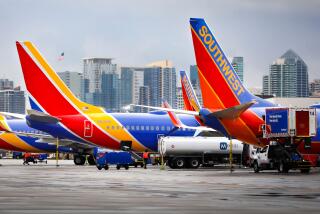What drink flusters flight attendants? And is that a dead body?
- Share via
Heather Poole is the fly-and-tell queen of the skies. She wrote about her 15 years and counting as a flight attendant in her book “Cruising Attitude,” but I follow her on Twitter (she’s a prolific tweeter) and always find the tidbits she shares about life in the sky enlightening.
An example: “Of all the drinks we serve, Diet Coke takes the most time to pour — the fizz takes forever to settle at 35,000 feet. In the time it takes me to pour a single cup of Diet Coke, I can serve three passengers a different beverage. So even though giving cans to first-class passengers is a big no-no, you’ll occasionally spy 12 ounces of silver trimmed in red sitting up there.”
That’s from “10 Shocking Secrets of Flight Attendants,” in which she also explains why it’s not a good idea to sneak a dead body onto a plane (some have tried) and that technically it’s not illegal to join the Mile High Club, but it is against the law to disobey the flight attendant who orders you out of the bathroom -- now!
As of 2010, there were about 90,500 flight attendants in the U.S. making a median income of $34,740 per year, according to the U.S. Bureau of Labor Statistics’ Occupational Outlook Handbook. Poole notes that newbies must be able to survive on about $18,000 a year and that seniority matters even when crew members are off the clock.
“Our tenure on the job doesn’t just determine which routes we fly and which days we get to take off; it also affects the hierarchy in our crashpad, an apartment shared by as many as 20 flight attendants. Seniority is the difference between top or lower bunk, what floor your bed is on, and just how far away your room is from noisy areas such as doors or stairwells.”
All good to know for job seekers -- and fliers like me who might skip the Diet Coke to give a flight attendant a break.
More to Read
Sign up for The Wild
We’ll help you find the best places to hike, bike and run, as well as the perfect silent spots for meditation and yoga.
You may occasionally receive promotional content from the Los Angeles Times.







